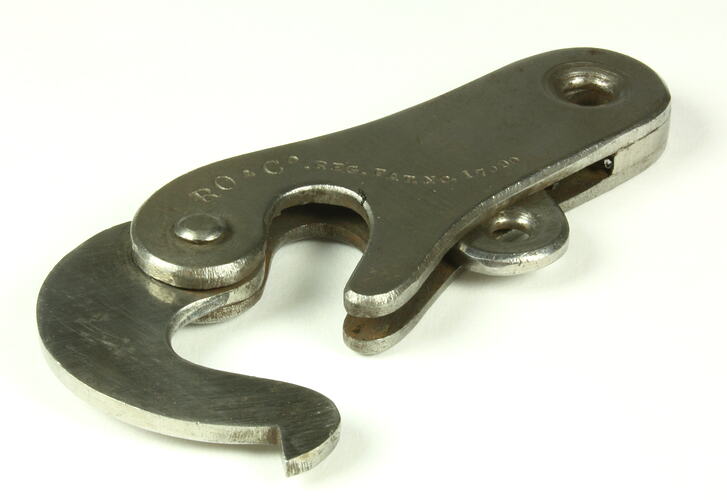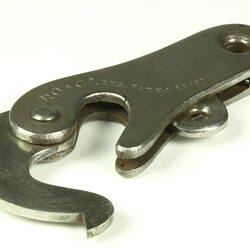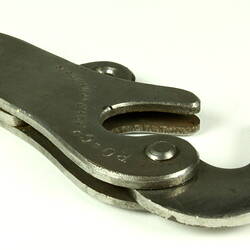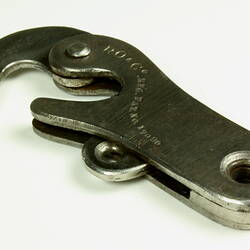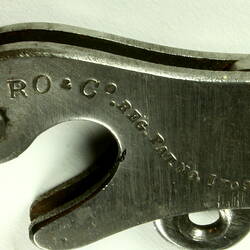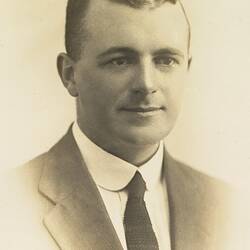Summary
Steel shackle or releasing hook of a type used for dropping bombs from military aircraft during the early part of World War I. Markings on the part indicate that it was manufactured by Rubery, Owen & Co, of Darlaston, South Staffordshire, England, to a registered patent design. The hook was associated with the donor's son, Basil Watson, who built a Sopwith type single-seat biplane, in July-October 1916.
Basil Watson was introduced to flying by Harry Hawker during an Australian publicity tour in early 1914, and subsequently travelled to England with Hawker, where he undertook flying lessons and worked as an engineer with the Sopwith Aviation Company. After the outbreak of WWI he was seconded to the British Government as a military test pilot, based at Brooklands aerodrome. He was severely injured in a crash after suffering an engine failure on take-off during a test flight in June 1915, and returned to Australia 12 months later, after being declared medically unfit for further military service. After constructing his own biplane from scratch at his parent's home in Elsternwick, in little more than 3 months, Watson piloted the aircraft on pioneering flights to Bendigo, western Victoria and Mount Gambier. He performed the first public aerial acrobatics flying demonstrations for crowds of spectators in Melbourne and country towns, and flew the first official airmail between Mt Gambier and Melbourne in February 1917. He was killed on 28th March 1917 when his aircraft crashed in shallow water in Port Phillip Bay, after a structural failure occurred as he performed an aerobatics display over Point Cook, Victoria. His death was the earliest recorded aviation fatality in Australia.
Presented to the Museum in 1919 by James Isaac Watson, father of Basil Watson, together with the Gnome aero engine, several spare parts and other items salvaged from the wreckage of the crashed aircraft. It is not known how or for what purpose Basil Watson acquired the hook or whether it was directly associated with his plane in any way.
The firm Rubery, Owen & Co. was established in 1884 by John Tunner Rubery (1849-1920) and his two brothers Samuel Rubery and Thomas William Rubery, operating as an ironworks manufacturing gates and fences. In 1893 the two brothers retired and were replaced by a trained engineer Alfred Ernest Owen, with the company name subsequently changing to Rubery, Owen & Co. in 1903. During the early 1900s, the firm diversified into the manufacture of chassis frames and components for the British motor vehicle manufacturing industry and general structural ironwork such as steel roofing frames and bridge girders. The partnership was dissolved in June 1910, with A.E. Owen continuing as sole proprietor. By 1912, the firm was also making aircraft components and accessories and during World War I became major contractors to the British Admiralty and War Office, supplying parts such as R.O. & Co.'s patent release gears, Fox's patent wire bending pliers, 'Short' patent turnbuckles, eye bolts, steel cable ends, pressed steel ribs and fuselage angle plates. It is possible that Basil Watson acquired a number of specialist fittings for his aircraft from Rubery Owen.
Physical Description
Steel shackle with hinged releasing hook and clasp. Fabricated from stamped parts in three layers riveted together. Electroplated with nickel or chrome.
More Information
-
Collection Names
-
Collecting Areas
-
Acquisition Information
Donation from James I. Watson, 28 Oct 1919
-
Inscriptions
Stamped or impressed on one side with the lettering: 'RO & Co. REG. PAT. No. 17090'
-
Brand Names
Rubery Owen (Aircraft Components) , R O & Co (Aircraft Components)
-
Classification
-
Category
-
Discipline
-
Type of item
-
Keywords
Aeroplane Components, Aircraft, Aircraft Manufacture, Aviation, Aviation Pioneers, Biplanes, Military Aircraft Components, Shackles, World War I, 1914-1918
